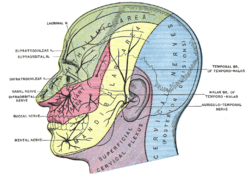Buccinator branch
| Buccal nerve | |
|---|---|

Sensory areas of the head, showing the general distribution of the three divisions of the trigeminal nerve (buccal nerve labeled at center left)
|
|

|
|
| Details | |
| From | Mandibular nerve |
| Innervates | Lateral pterygoid muscle and cheek |
| Identifiers | |
| Latin | Nervus buccalis |
| Dorlands /Elsevier |
n_05/12565268 |
| TA | A14.2.01.073 |
| FMA | 53066 |
|
Anatomical terms of neuroanatomy
[]
|
|
The buccal nerve (long buccal nerve) is a nerve in the face. It is a branch of the mandibular nerve (which is itself a branch of the trigeminal nerve) and transmits sensory information from skin over the buccal membrane (in general, the cheek) and from the second and third molar teeth. Not to be confused with the buccal branch of the facial nerve which transmits motor information to the buccinator muscle.
It courses between the two heads of the lateral pterygoid muscle, underneath the tendon of the temporalis muscle, and then under the masseter muscle to connect with the buccal branches of the facial nerve on the surface of the buccinator muscle.
Small branches of the buccal nerve innervate the lateral pterygoid muscle. It also gives sensory branches to the cheek.
The facial nerve (CN VII) also has buccal branches, which carry motor innervation to the buccinator muscle, a muscle of facial expression. This follows from the trigeminal (V3) supplying all muscles of mastication and the facial (VII) supplying all muscles of facial expression.
The nerves of the scalp, face, and side of neck.
Infaorbital and buccal nerve.Superficial dissection.Lateral view.
...
Wikipedia
